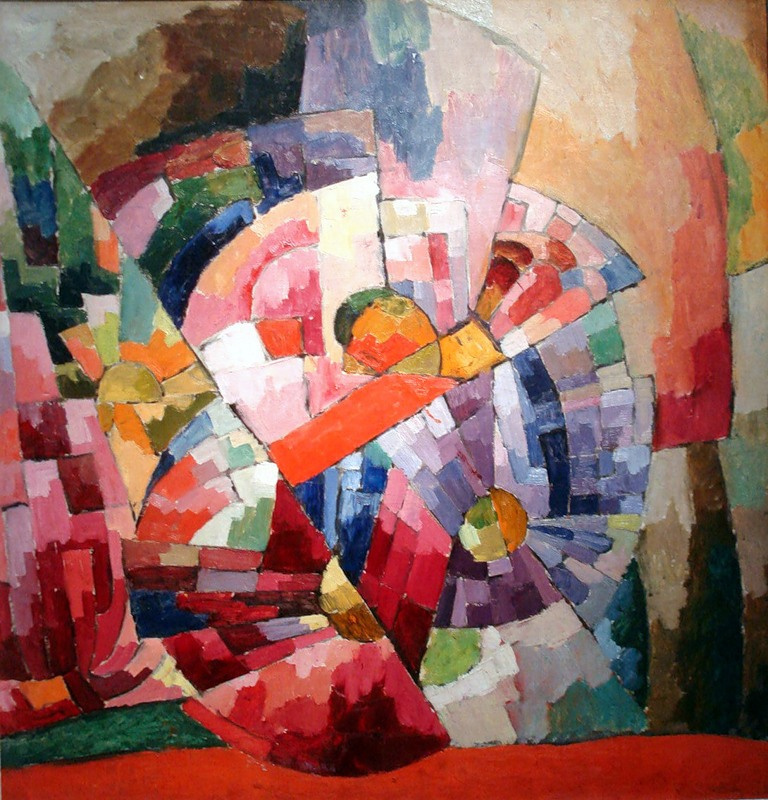log in
Enter site
Login to use Arthive functionality to the maximum
Asters
Aristarkh Lentulov • Painting, 1913, 96.5×101.5 cm
Description of the artwork «Asters»
"Asters" part of a series of abstract still lifes, Lentulov written on his return from Paris.
In France, the artist familiar with the work Robert Delaunayand Frantisek Kupka that during those years, away from the figurative and wrote in a manner orphism (branch cubism focused primarily on colour and musicality of the image and echoes the expressionism). Their influence is seen in abstract painting Lentulov.
Aristarkh Lentulov was a master of color and felt it was very important to his sound, the musicality. "Painting is supposed to sound!" – he said, seeing no point in "silent" images. Indeed, the canvas with the "Asters" pouring sounds, reproducing in front of us "song" of the bouquet. Low tones at the bottom of the picture to the top of the canvas getting taller, thinner, louder and clearer.
In this picture clearly visible feature of the interpretation of cubism Lentulov. For him the key was not broken into shape, and dispersion on canvas of colour, which combine to have an emotional impact on the viewer. The color richness is a distinctive feature Lentulov, in principle, in whatever direction it may work, except that the later paintings in the style of socialist realism.
His abstraction is not the abstraction of form, and especially color abstraction. Space paintings are built on color combinations, weaves and transitions. At the same curved plane intersect and are superimposed on each other, while maintaining planar sense, without turning into a volume. And, of course, "Astr" visibly "branded" sunshine Lentulov. As such, the images of the sun here, except that the circular sectors again, but the feeling of inner soft "lighting" the sun is, and this is the bar by which painting Lentulov can be distinguished from any other works of this generous on experiments (and in art and in society) era.
Author: Alain Esaulova
In France, the artist familiar with the work Robert Delaunayand Frantisek Kupka that during those years, away from the figurative and wrote in a manner orphism (branch cubism focused primarily on colour and musicality of the image and echoes the expressionism). Their influence is seen in abstract painting Lentulov.
Aristarkh Lentulov was a master of color and felt it was very important to his sound, the musicality. "Painting is supposed to sound!" – he said, seeing no point in "silent" images. Indeed, the canvas with the "Asters" pouring sounds, reproducing in front of us "song" of the bouquet. Low tones at the bottom of the picture to the top of the canvas getting taller, thinner, louder and clearer.
In this picture clearly visible feature of the interpretation of cubism Lentulov. For him the key was not broken into shape, and dispersion on canvas of colour, which combine to have an emotional impact on the viewer. The color richness is a distinctive feature Lentulov, in principle, in whatever direction it may work, except that the later paintings in the style of socialist realism.
His abstraction is not the abstraction of form, and especially color abstraction. Space paintings are built on color combinations, weaves and transitions. At the same curved plane intersect and are superimposed on each other, while maintaining planar sense, without turning into a volume. And, of course, "Astr" visibly "branded" sunshine Lentulov. As such, the images of the sun here, except that the circular sectors again, but the feeling of inner soft "lighting" the sun is, and this is the bar by which painting Lentulov can be distinguished from any other works of this generous on experiments (and in art and in society) era.
Author: Alain Esaulova


